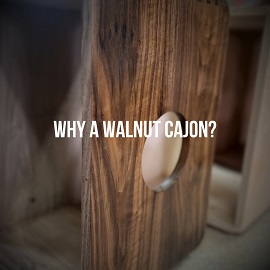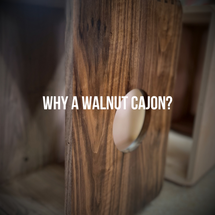Posted by StephenHead on 27th May 2023
What Makes Walnut a Great Cajon Building Material.
Introduction
When it comes to constructing a Kopf percussion cajon, my choice of wood is crucial in determining its overall quality and sound. Among the various wood options available, walnut stands out as an excellent choice to me. In this article, I will explore the reasons why I hold walnut in high regarded for building exceptional cajons.

Characteristics of Walnut Wood
Walnut wood possesses several characteristics that I believe make it ideal for cajon construction. As a hardwood, walnut offers exceptional strength and durability, ensuring that the cajon can withstand continuous playing and the test of time. Additionally, walnut wood is renowned for its natural beauty, boasting rich colors and distinct grain patterns. These aesthetic qualities add visual allure to the cajon, making it captivating both on and off stage.
Acoustic Properties of Walnut Wood
One of the primary reasons I favor walnut cajons is the exceptional acoustic properties offered by this wood. Walnut wood exhibits remarkable resonance and tonal qualities, resulting in a warm and rich sound profile. When a walnut cajon is played, it produces deep and resonant bass tones accompanied by a pleasing mid-range response. This unique tonal character sets walnut cajons apart from those constructed with other types of wood, making them the preferred choice for many musicians seeking a distinctive and captivating sound.
Workability and Craftsmanship
Crafting a cajon requires meticulous attention to detail and a profound understanding of woodworking techniques. In this regard, walnut wood excels due to its exceptional workability. Walnut is relatively easy to cut, shape, and join, allowing me to achieve precise dimensions and intricate designs. The workability of walnut wood also contributes to the ease of finishing and polishing, resulting in a smooth and visually appealing surface. The combination of craftsmanship and the unique grain patterns of walnut wood creates a stunning instrument that stands out both in terms of aesthetics and sound quality.
Sustainability and Environmental Benefits
Over the years, I have become increasingly focused on sustainability, choosing materials with minimal environmental impact has become crucial. Walnut wood offers a sustainable solution for cajon construction. Its relatively fast growth rate and widespread availability enable responsible sourcing and harvesting. By ensuring that the wood used for walnut cajons comes from sustainably managed forests, we can contribute to a greener future. Certifications such as the Forest Stewardship Council (FSC) guarantee that the walnut wood used in my shop meets stringent environmental standards. By opting for walnut Kopf Percussion cajons, musicians can enjoy the rhythm while supporting sustainability.
Longevity and Stability
When investing in a musical instrument, considering its longevity and stability is essential. Fortunately, walnut cajons excel in both aspects. Walnut wood exhibits exceptional stability, resisting warping and cracking over time. This durability ensures that the cajon maintains its structural integrity and tonal qualities throughout years of playing. Whether it's a rigorous live performance or a studio recording session, Kopf Percussion walnut cajons are built to withstand the demands of professional musicians and enthusiasts alike.
Versatility and Adaptability
Kopf Percussion Walnut cajons offer versatility in terms of musical genres and playing styles. The tonal qualities of walnut wood make it suitable for a wide range of music, including jazz, flamenco, pop, and world music. Furthermore, walnut cajons can adapt to different playing techniques, allowing musicians to explore various rhythmic patterns and dynamics. This adaptability enables musicians to unleash their creativity and push the boundaries of their rhythmic expression. Additionally, my walnut cajons often come with customization options, allowing musicians to personalize their instrument with unique artistic detailing, finishes, and adjustable snare systems.
Price and Availability
While Kopf Percussion walnut cajons may have a slightly higher price point compared to cajons made from other woods, they offer excellent value for money. Investing in a walnut cajon not only reflects its quality but also signifies a commitment to musical excellence.
Conclusion
Walnut wood possesses a remarkable combination of acoustic properties, workability, sustainability, and aesthetic appeal, making it an exceptional choice for building cajons. The strength and durability of walnut, coupled with its distinct tonal qualities, contribute to a fulfilling musical experience for both performers and audiences. Whether you're a professional musician or an enthusiastic beginner, investing in a walnut cajon can elevate your percussion journey to new heights, allowing you to explore a world of rhythmic possibilities.
FAQs
Can beginners use walnut cajons?
Absolutely! Walnut cajons are suitable for beginners as well as professionals. Their warm and rich sound, combined with ease of playability, makes them a great choice for anyone starting their musical journey.
How does walnut wood compare to birch for cajon construction?
While both walnut and birch are excellent choices, walnut wood offers a deeper and warmer tone compared to birch. The choice between the two depends on personal preference and the desired sound characteristics.
Are there any specific care instructions for walnut cajons?
To ensure the longevity of your walnut cajon, it's important to keep it away from extreme temperatures and humidity. Regularly cleaning the surface and applying a suitable wood conditioner will help maintain its appearance and protect it from wear.
Can walnut cajons be used in outdoor performances?
Walnut cajons can be used in outdoor performances; however, it's recommended to protect them from direct exposure to rain or prolonged sunlight. Using a protective cover or keeping the cajon in a shaded area will help preserve its condition.
Are there any alternative woods for cajon construction?
Yes, several other woods are commonly used for cajon construction, including birch, maple, oak, and mahogany. Each wood type offers unique acoustic properties and aesthetics, allowing musicians to choose according to their preferences and desired sound.
As an Amazon Associate, I earn from qualifying purchases. This means that if you click on the link and make a purchase, I may receive a small commission at no extra cost to you. This helps support my work in providing quality content. Thank you for your support!
Check out my blog post:



